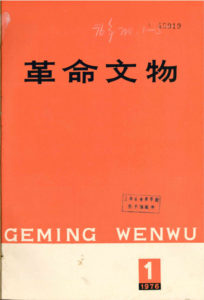Artifacts of the Revolution (1976)
Artifacts of the Revolution (1976)
The periodical Artifacts of the Revolution (Geming wenwu 革命文物) was a bimonthly publication starting to appear in April 1976. It was a declared project of Hua Guofeng 华国锋 who at that time was struggling with Jiang Qing 江青 and the Gang of Four 四人帮 on the question who should be considered the true successor of Mao Zedong 毛泽东. After the death of Zhou Enlai 周恩来 on January 8, 1976 Hua had taken over the post as acting Premier of the PRC and as the First Vice Chairman of the Communist Party of China. He regarded himself as the legitimate successor to the Great Chairman, yet had to justify this claim, which he did by presenting a ‘testament’ in Mao’s handwriting that also included the most famous saying that reproduced by Hua again and again at that time, namely “With you in charge, I’m at ease” (Ni banshi, wo fangxin 你办事我放心).
The periodical that appeared in the same month was thought to pass down this message to the people. It intended to put Hua Guofeng in a lineage of revolutionary fighters since the founding of the Communist Party in 1921. Considering that the late era of the Cultural Revolution was still a time of two political lines antagonizing each other, he could not simply prove his legitimacy by taking either side (which in his specific situation might have meant to condemn the Gang of Four and to support Deng Xiaoping). Instead, the first issue of the journal did not only confirm Hua as Premier, but also expelled Deng from the party as decided by the Central Committee of the Communist Party on April 7, 1976. This journal was however not only a reaction to the Tiananmen Incident of April 1976 where at the eve of China’s annual Qingming Festival thousands of people gathered to commemorate the life and death of Zhou Enlai (thereby attacking Jiang Qing and the Gang of Four for their alleged evil actions against the former Premier). The protests on the Tiananmen Square attacked namely not only political enemies, but also tried to annihilate the memory of the revolution: when Hua Guofeng—in his role as the head of public security forces—had ordered to remove the wreaths and other commemorative materials put in front of the Monument to the People’s Heroes he incited the anger of the mourners, and as a consequence not only vehicles were burned and offices ransacked, but also the Museum of Revolutionary History (Geming lishi bowuguan 革命历史博物馆) was attacked. Four attacks by counter-revolutionary forces, the first issue of the periodical reports, cadres and workers in the museum were injured, and there were efforts of an arson attack. [1] The arson was impeded, yet showed—as argued in a contribution in the second number of the journal—that protecting revolutionary artifacts by the masses was a result of the Cultural Revolution. In this sense, the periodical viewed itself as a support of the heroic task to protect and restore historic sites, to collect artifacts, and to organize exhibitions. [2]
At the same time, Artifacts of the Revolution propagated Hua Guofeng as the new leader by tying him to the revolutionary heritage by concentrating on artifacts that were proven relics of the revolutionary movement. The material existence of these artifacts was thought to show this link without relying exclusively on ideological statements. It rather tried to create an authentic, or ontological, memory of the revolutionary past, and this turn—that can retrospectively be called an authentic turn—explains why throughout all the issues of the Artifacts of the Revolution (1976-1980) there were calls to rescue and collect the traces of the past (shiji 事迹, zuji 足迹, yiji 遗迹).
[1] Relie huanhu Mao zhuxi wuchan jieji geming luxian de weida shengli 热烈欢呼毛主席无产阶级革命路线的伟大胜利, Geming wenwu, no. 1, 1976.
[2] Yang Zheng 杨峥 (1976): Geming wenwu gongzuo zai douzheng zhong polang qianjin 革命文物工作在斗争中破浪前进, in: Geming wenwu, no. 2, pp. 5-6, 45.
Marc Matten
